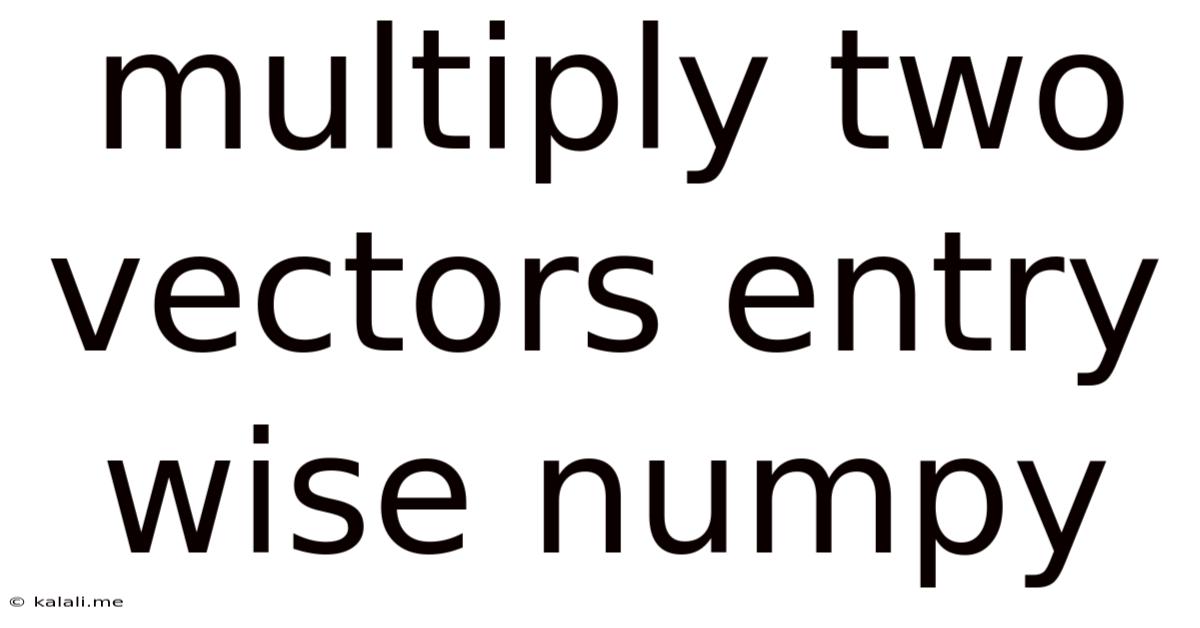Multiply Two Vectors Entry Wise Numpy
Kalali
Jun 10, 2025 · 3 min read

Table of Contents
Multiply Two Vectors Entry-Wise Using NumPy: A Comprehensive Guide
This article will guide you through the efficient and elegant ways to perform entry-wise multiplication of two vectors using the powerful NumPy library in Python. Entry-wise multiplication, also known as Hadamard product, involves multiplying corresponding elements of two vectors to produce a new vector of the same dimensions. This operation is fundamental in various fields like linear algebra, machine learning, and data science. We'll cover different scenarios and best practices to ensure your code is optimized and readable.
Understanding Entry-Wise Multiplication
Before diving into the NumPy implementation, let's clarify what entry-wise multiplication entails. Consider two vectors, a and b, of the same length:
a = [a1, a2, a3, ..., an]
b = [b1, b2, b3, ..., bn]
The entry-wise product, denoted as a ⊙ b, is a new vector c where:
c = [a1*b1, a2*b2, a3*b3, ..., an*bn]
Each element in c is the product of the corresponding elements in a and b.
NumPy's Efficient Approach
NumPy provides a highly optimized way to perform this operation using the * operator. This operator, when used with NumPy arrays, performs element-wise multiplication, avoiding the need for explicit loops which are significantly slower for large vectors.
Example 1: Basic Entry-Wise Multiplication
import numpy as np
a = np.array([1, 2, 3, 4])
b = np.array([5, 6, 7, 8])
c = a * b # Entry-wise multiplication
print(c) # Output: [ 5 12 21 32]
This concise code snippet demonstrates the simplicity and efficiency of NumPy for entry-wise multiplication. The * operator automatically handles the element-wise operation, generating the desired result.
Example 2: Handling Vectors of Different Dimensions
Attempting to multiply vectors of differing dimensions will raise a ValueError. NumPy requires the vectors to be broadcastable (meaning they have compatible dimensions for element-wise operations). Ensure your vectors have the same length before performing the multiplication.
Example 3: Using np.multiply() Function
While the * operator is the most common and efficient method, NumPy also provides the np.multiply() function, which achieves the same result:
import numpy as np
a = np.array([1, 2, 3, 4])
b = np.array([5, 6, 7, 8])
c = np.multiply(a, b)
print(c) # Output: [ 5 12 21 32]
This function is functionally equivalent to the * operator but might be preferred for improved code readability in some contexts.
Example 4: Working with 2D arrays (Matrices)
The entry-wise multiplication using * or np.multiply() also extends seamlessly to 2D arrays (matrices). The operation will be performed element by element between corresponding positions in the arrays:
import numpy as np
A = np.array([[1, 2], [3, 4]])
B = np.array([[5, 6], [7, 8]])
C = A * B # Element-wise multiplication of matrices
print(C) # Output: [[ 5 12] [21 32]]
Remember that this differs from matrix multiplication (dot product), which requires a different operation (np.dot() or @ operator).
Best Practices and Considerations:
- Vectorization: Always leverage NumPy's vectorized operations to achieve optimal performance. Avoid explicit loops unless absolutely necessary.
- Data Type: Be mindful of the data types of your vectors. Inaccurate results might occur if the data types are incompatible.
- Error Handling: Implement appropriate error handling, particularly for scenarios involving vectors of different dimensions.
- Readability: Choose the notation (
*ornp.multiply()) that enhances the readability of your code.
By understanding and applying these techniques, you can efficiently and effectively perform entry-wise vector multiplication in Python using NumPy, a fundamental operation in many computational tasks.
Latest Posts
Latest Posts
-
How Long Would It Take To Drive 2000 Miles
Jul 01, 2025
-
What Color Does Black And Blue Make
Jul 01, 2025
-
How To Pass Level 7 In Bloxorz
Jul 01, 2025
-
How Much Years Is 1 Billion Minutes
Jul 01, 2025
-
I Reject Your Reality And I Substitute My Own
Jul 01, 2025
Related Post
Thank you for visiting our website which covers about Multiply Two Vectors Entry Wise Numpy . We hope the information provided has been useful to you. Feel free to contact us if you have any questions or need further assistance. See you next time and don't miss to bookmark.